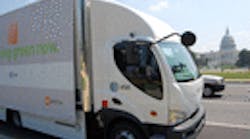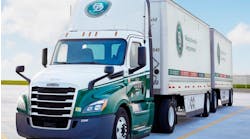An alternative truck power list
More fleets than ever before are considering adding alternative power vehicles to their operations. The move may be driven by the need to help offset the high (and highly variable) cost of diesel or gasoline; by new regulatory requirements; by pressures to implement a sustainability initiative; by a desire to prepare now for the probable regulation of greenhouse gas emissions; or by a determination to test new technologies to stay ahead of the innovation pack. Whatever the rationale, the good news is that there have never been so many options from which to choose. Alas, that is also the bad news.
While there are numerous technologies available, each one brings with it a unique set of benefits and limitations. The challenge is to find the best alternative power solution(s) for your operation in order to optimize the return on investment and avoid potential obstacles to success.
If any one alternative power choice can be said to have center stage at the moment, it is natural gas. In either compressed (CNG) or liquefied form (LNG), natural gas as a vehicle fuel is also fueling high hopes for a cleaner energy future.
According to consultant Robert Hall, recently tapped to head the new Natural Gas Vehicle Fleet Forum, natural gas offers fleets a less expensive fuel, delivers about a 20% improvement in regulated emissions, and does not significantly increase maintenance costs. In terms of domestic energy security, natural gas is available in abundant supply, although estimates for just how much actually exists in the U.S. vary widely. There are also tax credits and grants available to help offset the higher purchase price for natural gas-powered vehicles.
As perfect as all that sounds, deploying natural gas vehicles is not without its challenges, however, including the need for many more fueling stations, and the relatively high cost of building out that infrastructure. Hall notes that natural gas vehicles typically cost $25,000 to $75,000 more than similar diesel- or gasoline-powered vehicles and that fleets also pay a penalty in terms of weight and range of operation between fueling stops. Maintenance issues also differ, he says, requiring some special training for the technicians who service them.
Ryder System is known for its use of alternative power vehicles, including hybrids and biodiesel-fueled trucks. At the recent Alternative Clean Transportation (ACT) Expo, Scott Perry, the company's group director of vehicle supply management, discussed how Ryder is also deploying 202 natural gas tractors and building fueling stations and maintenance facilities in California. “There is not an application we do not intend to address with these vehicles,” Perry says, “including grocery, food and beverage distribution, bulk, drayage, utilities and municipal support.”
Ryder elected to add natural gas vehicles to its own fleet and the lease/rental fleet for a variety of reasons, he notes, including the fact that the company is “well-positioned to deal with the complexities associated with properly maintaining natural gas vehicles to guarantee uptime and compliance.”
Among the limitations of natural gas, Perry points out operating “range anxiety”; the premium for investing in natural gas vehicles, which makes it harder to realize an ROI without financial incentives; and the limited portfolio of available engine choices. He also stresses the need for more fueling stations. “You must [also] make sure the fueling stations [you are counting on] can handle tractor-trailers,” he says. “Many were designed just for passenger vehicles.”
So what is the “sweet spot” for using natural gas vehicles? Among the factors Hall lists are the ability to fuel centrally or to have easy access to fueling stations, OEM support, good maintenance practices and well-trained technicians, and proper and regular cylinder inspections.
PLENTY OF VARIETY
Hybrid vehicles are so often lumped together into one category that it is easy to forget there are numerous variations on the hybrid theme, including diesel-electric, gasoline-electric or diesel-hydraulic combinations. There are also a few hybrids that incorporate natural gas or even fuel cells. This makes the task of matching hybrid vehicles to particular applications and duty cycles a more nuanced exercise than is necessarily the case with other alternative power options; however, the payoffs can be well worth the planning effort.
The value proposition for commercial hybrid vehicles is strongest for vehicles in stop-and-go operations and for vehicles that can use hydraulic or electric power to operate chassis-mounted equipment, such as lifts on utility trucks. The California Hybrid Truck and Bus Voucher Incentive Project notes that testing conducted by CALSTART for the Hybrid Truck Users Forum found fuel use reductions of 14 to 58% and reduced brake wear in hybrid-electric bucket trucks. In addition, the National Renewable Energy Laboratory tested hybrid-electric delivery vans operated by UPS and found fuel-economy gains of 29 to 37%.
Coca-Cola Refreshments USA Inc. has been a leader in the adoption of hybrid trucks, which the company began adding to its fleet in 2007 with an initial purchase of 50 trucks. According to Tony Eiermann, fleet asset manager for Coca-Cola, hybrid vehicle purchases outnumbered diesel purchases last year and hybrids now represent 7 to 8% of the total fleet.
Eiermann says that the company plans to add more hybrids, including hydraulic hybrids and light-duty hybrids, to the fleet in the future along with other alternative power vehicles, such as all-electric and natural gas. “You have to be very strategic in deploying hybrids, however,” he notes, “if you are going to realize the full fuel-economy benefits.”
Based upon his experiences, Eiermann considers 20 to 30 mph to be the optimum operating speed for hybrids, with “minimal miles over 45 mph.” Since hybrids capture and store kinetic energy usually lost during braking, a good stopping density of more than two stops per mile is important, he notes, as is making sure that drivers are helping to keep hybrids working within their optimal performance ranges.
FIRING UP PROPANE
Fleets, especially those running gasoline-powered vehicles, have another alternative power option from which to choose — propane. (Because propane is spark-ignited like gasoline, you can't switch a diesel vehicle to propane without also shifting to a propane injection system, which requires engine modifications.)
Although propane is a hydrocarbon found with natural gas or derived from the process of refining crude oil into various products, propane yields about 12% less carbon dioxide and 20% less nitrous oxide than gasoline. Brian Feehan, vice president of the Propane Education and Research Council, says propane is available in plentiful amounts domestically, too, and currently costs about 30% less than gasoline, based on national averages.
Propane also has a high octane rating of 104. According to supplier Ferrellgas, that allows for a higher compression ratio in the engine and greater engine efficiency. It also notes that the driving range of propane vehicles is “more than 250% farther than compressed natural gas, about 60% farther than methanol and about 25% farther than ethanol.”
While propane availability is not as significant an issue as it is for natural gas (there are over 2,500 public propane fueling stations in the U.S.), it is still not an on-every-street-corner fuel, although it is relatively easy to transport and store.
Also bear in mind that switching to propane requires converting a new or used conventionally powered vehicle; it is not just a matter of driving a propane-powered truck off the dealer's lot. Some OEMs like Ford and GM, however, offer new chassis already prepared to be converted to propane by companies like Roush CleanTech for Ford commercial vehicles or CleanFuel USA for General Motors commercial fleet products.
When it comes to diesel engines, Feehan says that retrofits are currently available only for used Caterpillar 3406 engines and older and certain Cummins 11L engines.
ALL-ELECTRIC
When considering battery-powered vehicles, “range is the key word,” says Jeff Kessen, director of transportation marketing for A123 Systems, a supplier of lithium-ion batteries, including batteries for hybrid vehicles and for plug-in electric chassis. “It is the most important thing to think about. You might be surprised at how much sense an all-electric truck can make if the range and application are right.”
When Kessen and other electric vehicle experts talk about range, they mean short, regular and steady. “The ROI calculation really depends upon how much you use the vehicle every day,” Kessen says. “If you buy a 100-mi. truck and drive it 70 to 80 mi. per day five days a week, in about one year, your battery costs will be equal to or less than what you would be paying to fuel a comparable conventionally powered vehicle.”
Mark Aubry, vice president of sales and marketing for electric vehicles at Navistar International, echoes Kessen's advice. International introduced the eStar all-electric van in 2010. “The ideal duty cycle is a regular route of 100 mi. per day or less with frequent starts and stops and a return to the same home base for recharging at the end of the shift,” he says. “That reduces so-called range anxiety, provides the best all-around vehicle performance, reduces maintenance and repair issues, and reduces or eliminates the need to build out a network of charging stations.”
Aubry says electric vehicles can handle hills, too, in spite of popular opinion to the contrary. “Yes, you will have a decrease in range in a hilly environment, but you recapture some of that going down the hills,” he notes. “Still, even in San Francisco, an electric vehicle could easily do 40 to 50 mi. per day.”
Because all-electric commercial vehicles are relatively new to the market, there is not a lot of data available about things such as total lifecycle costs, maintenance cycles and costs or residual value. “As far as lifespan goes, fewer moving parts should result in less wear and tear and less maintenance,” says Aubry. “We just don't know yet what the aftermarket will be.”
The electric vehicle market is not entirely devoted to light-duty trucks, however. Balwinder Samra, CEO & president of Balqon Corp., is convinced that there is also a place for medium- and heavy-duty all-electric vehicles.
“Our background is in electric ground support vehicles, such as fueling carts for airports and yard tractors,” Samra says. “Balqon has extended that experience to the development of a battery-powered heavy-duty tractor that can operate up to 16 hours without recharging.”
Samra acknowledges that the weight of the required batteries can be an issue for many over-the-road applications, but says there are plenty of jobs battery-powered vehicles can handle. Rail yards are being forced to go electric, he notes. “This is a market where you find applications [first] and then develop customized solutions,” he says.
There are other alternative power options to be had, of course, especially in the biofuels area. There is even a reviving interest in hydrogen. “Alternative power is a topic which will change the world,” keynote speaker Martin Daum, president and CEO of Daimler Trucks NA, told the audience at ACT Expo. “[It will be very important for years to come.]”
Editor's Note: For a listing of alternative power vehicles currently available, go to www.fleetowner.com and click on the alternative power link.



